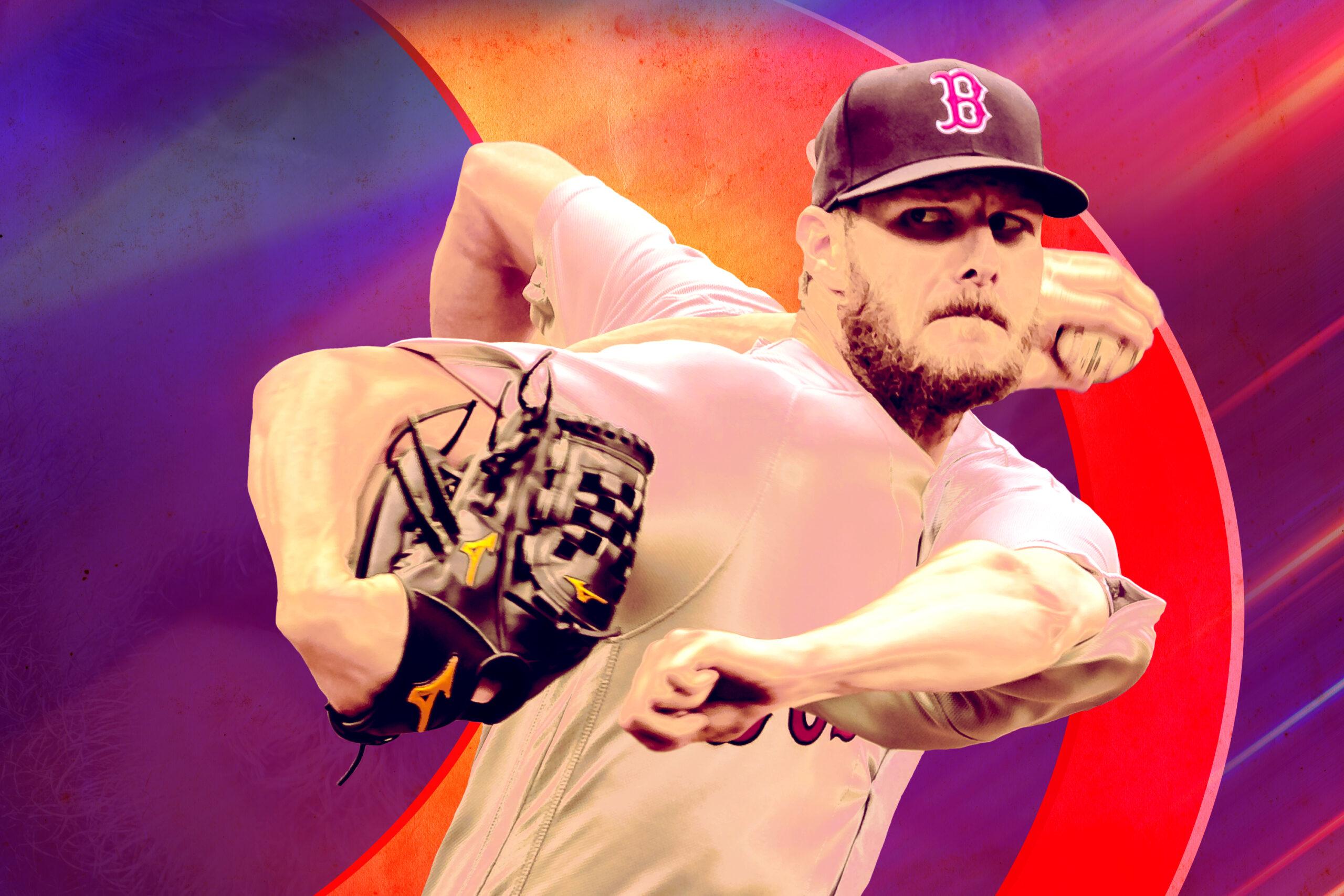
Chris Sale faced Chris Davis on Sunday, and the at-bats went as expected. Sale is the best strikeout pitcher in MLB history, Davis perhaps the most strikeout-prone hitter; Sale’s in the middle of his best season, Davis is in his worst; and it was a lefty-on-lefty matchup for good measure. Indeed, Davis struck out twice in two at-bats, and the first was almost an act of cruelty from Sale, who toyed with his food by running the count to 3-0 before storming back for the K.
Davis is far from Sale’s only victim this season; in fact, he provides a worthwhile point of comparison for the pitcher’s overwhelming dominance in 2018. Davis is batting .163/.245/.310, a slash line so poor that he has become the focus of numerous articles specifically detailing his struggles. All of Sale’s opponents combined, meanwhile, have hit .175/.239/.279. He’s turning the whole league into a slightly worse version of the worst everyday player in the majors. And that’s just an entry point into his dazzling season.
Boston is marching toward the all-time wins record—after Wednesday’s game, the 86-36 Red Sox are on pace for 114 wins—not because the team is flawless, but because its stars have been so resplendent that they have more than compensated for the roster’s surprisingly abundant holes. Mookie Betts might win the AL MVP award, except J.D. Martinez might also win the AL MVP award, and Craig Kimbrel ranks second in the majors with 36 saves. And then there’s Sale, who’s combining power, control, and contact management to resemble essentially the perfect pitcher.
In his first start back from the disabled list Sunday, the lanky—every article about the 6-foot-6, 180-pound Sale must describe him as lanky—lefty struck out 12 Orioles in five shutout innings while allowing one hit. Sure, Baltimore’s lineup included Davis as the no. 6 hitter and Renato Núñez, Austin Wynns, and Cedric Mullins at 7, 8, and 9, respectively, so the meager competition helped. But Sale’s recent run demonstrates that he doesn’t need such competitive aids. In his last start before Sunday’s, against Minnesota in late July, Sale struck out 10 in six shutout innings; before that, in reverse-chronological order, he struck out nine Tigers in six shutout innings, 12 Rangers in seven shutout innings, 12 Royals in six innings of one-run ball, 11 Yankees in seven shutout innings, and 13 Mariners in seven shutout innings.
Overall, Sale’s line through his last seven starts is a stunning bit of statistical wizardry: 6-0 record, 44 innings, one run, 0.20 ERA, 79 K, six BB. Expand the run back three more strikeout-filled games, and Sale has allowed five runs in his last 65 innings; for comparison, when Zach Britton received Cy Young and MVP consideration for his historically great season as a closer in 2016, the Orioles southpaw allowed seven runs (four earned) in 67 innings.
This stretch represents a new peak for Sale, who in the process won the AL Pitcher of the Month award for both June and July, becoming the first Red Sox hurler to win consecutive honors since Pedro Martínez in 1999. It’s not as if he had much room to grow, either: Sale struck out 308 batters last year—the highest total for any pitcher since 2002—and led all qualified starters in FIP and FanGraphs’ version of WAR. Only a late Corey Kluber charge kept Sale from winning his first Cy Young. Boston would have been thrilled with any decent approximation of that performance in 2018, let alone a repeat, let alone a better campaign. He won’t reach 300 Ks this season due to a lesser innings load, but on a per-inning basis, he’s managed to improve.
So often, baseball analysis focuses on player changes—sluggers lifting their launch angles and pitchers changing their arm slots and, heck, Max Scherzer adding a new breaking ball to his repertoire. But none of these mechanical or strategic adjustments seem to apply to Sale: He hasn’t changed his pitch mix much, nor is he throwing disproportionately harder or generating more movement. He’s just boosted his underlying numbers by small amounts across the board, which has produced a compounding effect and made a Cy Young contender even better.
It’s somewhat strange to think of Sale allowing any sort of contact, given how many of his highlights involve a sweeping strike three and dejected walk back to the dugout, but he’s made his greatest strides in managing that contact when it comes. His ground ball rate has climbed to its highest point in five years, and he’s generating infield pop-ups at a career-best clip—among qualified starters, only Scherzer and J.A. Happ have done so at a higher rate—which gives him plenty more automatic outs in addition to those from his prodigious strikeout total. Overall, out of 237 pitchers who have thrown at least 10 innings as a starter this year, Sale has the highest soft-contact rate, and Statcast statistics that measure “expected” outcomes based on batted-ball data to strip out the effect of fielding also paint Sale as the most effective starter in the majors.
Then, there are those strikeouts; Sale’s an avid collector of those, too. Last year, he recorded what was the third-highest single-season strikeout rate in league history; if this season ended today, he’d set the record, besting Pedro’s 1999 rate. Here, too, Sale has improved by small amounts across the board—he’s getting ahead of batters with a career-best first-strike percentage, for instance, and though batters aren’t swinging more often than before, they are missing much more when they do. In the pitch-tracking era, no qualified starter has finished a season with a lower contact rate than Sale’s current mark. For comparison, when Kenley Jansen was the most unhittable closer in the majors last season, he posted the same contact rate that Sale has this year.
It turns out that a pitcher who induces soft contact more than any other pitcher this year and strikes out hitters more than any other pitcher ever produces pretty compelling results. Sale ranks second to Jacob deGrom in ERA (1.97) and leads the majors in all manner of advanced ERA estimators—FIP, xFIP, SIERA, DRA—that aim to provide a better measure of run suppression than straight runs allowed. Taken together, those metrics suggest that Sale hasn’t relied on luck to overperform his underlying numbers—his FIP, for instance, is 1.95—which is an absurd reality for a pitcher whose ERA is so low.
Zooming in to an individual pitch level, his fastball—tied for the second-fastest for any lefty starter—has been as indomitable as usual, while his slider has improved to become the most valuable in the majors; in 184 at-bats ending with that pitch, Sale has induced 105 strikeouts and allowed an opposing batting average of .103. Examined from any direction, with any number, Sale looks every bit the best pitcher in the American League, if not the majors overall.
And unlike last season, when he faded in the second half, Sale aims to stay fresher down the stretch in 2018. He ramped up his throwing schedule slower this spring than he has in the past, and in-season, he’s averaging 10 fewer pitches per game than he did through the same number of starts in 2017. At this point last year, he’d reached triple-digit pitch counts in all but two games, but he’s hit that number in only 13 out of 23 starts this season while throwing 15 1/3 fewer innings in the process. (Of course, this approach assumes that Sale will remain healthy, and though his recent DL stint due to shoulder inflammation didn’t derail his season—if anything, it afforded him further rest—a shoulder scare for any pitcher is never a positive sign.)
If that long-term outlook allows him to better maintain his torrid pace through the next six weeks, Sale’s season could end up near the top of historical leaderboards, not just 2018’s. At the moment, Sale’s ERA-, which adjusts his ERA for both his home park and the league-wide scoring environment and places it on a scale where 100 is average, is 45—meaning he’s been 55 percent better than average. That’s better than even deGrom’s 2018 mark (currently 47) and ties him for 16th on the all-time leaderboard, among some of the most treasured pitching seasons in the sport’s history. And his FIP- of 48 ranks even better—that ties him for fourth on the all-time leaderboard, with Pedro’s 2000 and Christy Mathewson’s 1908. Even a slight bump before the rest of the season could move Sale up to no. 2 all time (Randy Johnson holds that spot with a mark of 45).
Pedro leads that all-time leaderboard with an unfathomably great 31 FIP-, and Sale isn’t close enough that catching him is a real possibility. But there’s no shame in not precisely replicating Pedro’s peak performance. That Sale’s even in a peripheral conversation is high enough praise, and a perfectly poetic part of the best Red Sox season ever.

